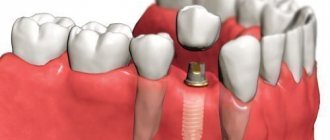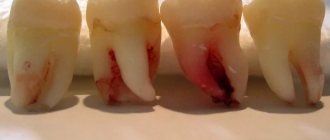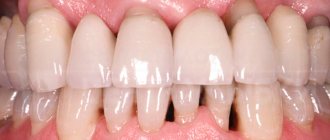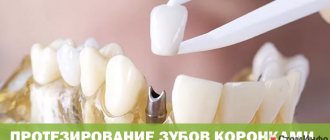What is a metal-ceramic crown?
Today, the choice of materials for making dental crowns is very wide: ceramics, zirconium dioxide, and plastic, but metal-ceramics continues to be the most popular and affordable. At the moment, metal ceramics are a kind of gold standard in dentistry, since similar designs have been used by doctors for many years and have proven themselves to be good.
Metal-ceramic crowns are a “cap” with machined fissures, which is placed on a ground tooth and completely imitates its shape, including all anatomical formations. The basis for the structure is a metal frame, which is covered on top with a layer of ceramics, indistinguishable in color from natural enamel. The prosthesis is secured to the ground dental tissues using special composite or glass ionomer cement. In case of severe destruction, a metal tab is first installed, which serves as a reliable basis for the crown. Metal-ceramics are also used for the manufacture of bridges and clasp dentures supported both on the patient’s own teeth and on dental implants. In the latter case, the use of implants with metal abutments is recommended.
Metal-ceramic dentures, what are they?
Fixed dental prostheses - crowns and bridges - are made from metal-ceramics. Such designs consist of two parts:
- frame: 0.3-0.5 mm thick, it is cast or milled from metal alloys - base or precious;
- veneering: its thickness reaches 1-1.5 mm, it is represented by dental ceramics, which is applied by spraying or casting and baked at a temperature of about 900°C.
It is thanks to the combination of a metal frame and a ceramic coating that both strength and a good imitation of natural teeth are ensured.
Metal-ceramics is a compromise between low-esthetic one-piece metal prostheses and expensive structures made of glass ceramics and zirconium dioxide.
Metal-ceramics is a popular method of dental prosthetics, which is characterized by high strength and excellent aesthetic properties.
Pros and cons of a metal-ceramic crown
Among the advantages of metal-ceramic crowns is, first of all, their strength. Therefore, in most cases they are installed on chewing teeth. Undoubtedly, they look much better than purely metal crowns. In general, metal-ceramic crowns imitate real teeth well, but with the advent of new materials in prosthetics, preference in restoring anterior teeth began to be given to all-ceramic structures. When a combination of reliability and aesthetics is needed in the chewing area, then the best choice would be ceramic prostheses based on zirconium dioxide.
Advantages and disadvantages of treating a tooth under a crown
Advantages of the technique:
- The patient will not have to incur additional expenses that are inevitable when removing and reinstalling a crown. The cost of treatment is comparable to the cost of standard re-therapy.
- The base material of the crown will not be damaged. The base is usually metal or zirconium oxide.
- A person is given the opportunity to save on installing new dentures and continue to wear the old ones for years.
Flaws:
- There is always a risk of damage to the top coating of the crown if it is ceramic. In this case, the costs of restoring the spraying are inevitable.
- Drilling a hole in the crown violates the integrity of the prosthesis, which affects its service life. You will have to replace the element earlier than would have been necessary without such intervention. Typically, the service life of a solid crown is 15 years.
What are the differences between metal-ceramic crowns?
Indeed, many patients wonder: what is better - zirconium crowns or metal-ceramics? Roughly speaking, both structures are metal-ceramic, but zirconium is a “white” material that does not shine through the ceramic, as sometimes happens with ordinary metal. Therefore, today ceramic crowns on a zirconium frame are close in aesthetic qualities to all-ceramic crowns, but at the same time they have the same strength as metal-ceramics. However, prices for such prostheses are higher than for metal-ceramic structures without the use of zirconium.
The question of which is better - metal-ceramic or ceramic crowns cannot be answered unequivocally. The choice is made depending on the indications and budget. So, if prosthetics of the frontal group of teeth is necessary, it is recommended to choose solid ceramics. It is aesthetic metal ceramics. Typically, such crowns are placed on teeth where the chewing load is less, since the metal-ceramic frame is stronger. Regarding the issue of price, a metal-ceramic crown is, of course, cheaper.
Kinds
When choosing metal-ceramic dentures, keep in mind that they differ greatly in strength, aesthetics and price, depending on the type. Therefore, check 3 points:
- what metal alloys the dental technician uses for the frame;
- What brand of ceramics is used to veneer the prosthesis;
- What technology will be used to make the structure?
To figure out which metal-ceramic crowns and dentures are the best, you need to know their types. These products are classified according to 3 criteria.
According to the material:
- Made of cobalt-chromium alloy. It is used most often because inexpensive, has good strength and good biocompatibility.
- Made from nickel-chrome alloy. More flexible than the previous material, but wears out faster and more often causes allergies.
- Made of titanium. It is expensive, but very durable, does not corrode, lasts longer than other materials, and is bioinert.
- Made from precious alloys. Such dentures are also called gold-ceramic. They are made of 85% gold, 9% platinum, 4% palladium and 2% other metals. The most expensive, but valued for their hypoallergenicity and ability to accurately imitate real teeth: the gold frame is slightly visible through the outer layer of ceramic and gives it a natural yellowish tint.
The base of the crowns is made of various alloys
According to the shape:
- Regular. They do not have the lower metal part, which is in contact with the gum, covered with ceramics. Over time, constant contact of metal with the mucosa causes it to turn blue, and the inevitable periodontal recession leads to exposure of the dark metal edge of the crown.
- With shoulder mass. Such prostheses are also called metal-ceramic crowns of increased aesthetics. Their lower edge is lined with glass ceramics - around the entire circumference or only on the front side, which is visible when you smile. This avoids turning the gums blue and exposing the edge of the metal frame.
By manufacturing method:
- Solid cast. Produced by casting from molten metal. The use of this technique requires a high level of professionalism of the orthopedic dentist and dental technician: inexperienced professionals make mistakes when taking impressions and making the frame, due to which the prosthesis does not fit tightly to the stump and does not correspond to the bite. Such mistakes affect the stability and durability of the structure.
- Milled using CAD/CAM technology. They are made using automatic installations: impressions are taken by an intraoral (intraoral) camera, and the frame is made on a programmed machine. This method almost completely eliminates manual work and reduces the likelihood of errors due to human factors to a minimum.
CAD/CAM - modern crown manufacturing technology
The best metal-ceramic crowns are highly aesthetic, made from gold-containing alloys, made using CAD/CAM technology. But the prices for such prostheses are off the charts. Most often, solid structures are installed from cobalt or nickel-chrome and without shoulder masses. Such products cost 3-4 times cheaper.
Types of metal-ceramic crowns
Metal-ceramic crowns have several classifications: according to the frame material and according to the ceramic material. Thus, according to the frame material, crowns are distinguished based on a chromium-nickel alloy, based on a cobalt-chromium alloy, and based on a gold-platinum (palladium) alloy (based on the so-called “noble alloys”). There is also another material that is used quite rarely - titanium alloy. Each of these types of metal-ceramic crowns has its own pros and cons. Traditionally, the most popular material is cobalt-chromium alloy. Based on the ceramic material, a distinction is made between conventional (high-temperature) and low-temperature ceramics. Low-temperature ceramics based on “noble” alloys look more aesthetically pleasing.
Indications and contraindications for metal-ceramic crowns
The indications for installing a metal-ceramic crown are the same as for crowns made of other materials. The main one is the index of destruction of the coronal surface of the tooth, equal to 0.6. Also, indications for installing a metal-ceramic crown are:
- any non-carious lesions, for example, fluorosis or enamel hypoplasia;
- abnormal development and position of the front teeth in adults, which for any reason cannot be eliminated by orthodontic methods;
- pathological abrasion or wedge-shaped defect;
- aesthetic defect in the crowns of natural teeth (changes in color and shape, loss of shine, etc.);
- inconsistency of existing artificial crowns with aesthetic and functional requirements;
- metal-ceramic crowns can also be used as a splinting structure for mild to moderate periodontitis;
Each of the above indications should be considered in the context of a specific clinical case. Contraindications include, for example, bruxism, as well as periodontitis, accompanied by severe tooth mobility. In addition, fixed prosthetics on implants also involves the use of metal-ceramic crowns.
Is it possible to put metal-ceramic crowns on the front teeth?
It is possible if the patient’s budget does not allow for all-ceramic crowns. There are no medical contraindications to the manufacture of metal-ceramic crowns on the frontal teeth. However, aesthetics in this case recedes into the background. Such crowns will not look very natural. Therefore, it is still better not to place metal-ceramic crowns on the front teeth.
Installing a metal-ceramic crown on a tooth
- The first stage of installing a metal-ceramic crown can be called clinical. The doctor treats the tooth and its canals, prepares dental tissue for the future crown and takes an impression.
- After this, the laboratory stage begins: in the laboratory, a crown frame is made, which we then try on, check its reliability and fit to the tooth, correct defects, if any, and also choose the color of the future structure. The frame is then taken back to the laboratory, where a technician applies ceramic paste to it.
- When the crown is ready, the doctor invites the patient to an appointment and installs it.
While the prosthesis is being manufactured, which can last from one to two weeks, a temporary crown is installed on the tooth.
Metal-ceramic crown with shoulder
There are no metal-ceramic crowns with a shoulder. The tooth is ground with a shoulder, and the metal-ceramic crown is made with a ceramic shoulder. That is, the edges of the metal frame of the crown are lined with a special “shoulder” ceramic mass. This is done to improve the aesthetics of prosthetics with metal-ceramic crowns, as well as to prevent “cyanosis” (translucency of the metal frame) in the crown-tooth transition zone.
Before and after installation of a metal-ceramic crown. Work by Movsisyan V.K.
Possible causes of pain
Most often, before installing a crown, the dentist performs depulpation. Pulp is a loose tissue that is located inside the tooth and is penetrated by many blood vessels and nerve endings. Therefore, this procedure is colloquially referred to as nerve removal. It is generally accepted that pulpless teeth do not hurt and do not cause problems. In fact, this is not entirely true, since inflammatory processes often spread to surrounding tissues.
Inflammation is one of the most common causes of pain in a pulpless tooth under the crown. It is important to note that the factors that provoke the development of the inflammatory process are:
- Inadequate tooth preparation. A correctly performed procedure assumes that the pulp will be completely removed, and the canals will be disinfected and sealed to a physiological level. If the canal is not completely sealed, the resulting cavity creates conditions favorable for the development of bacteria. The same thing happens when using low-quality filling materials - over time, they sag and form voids into which infection penetrates, resulting in inflammation.
- Root canal perforation. As a rule, the thickness of the canal walls is small, so in complex anatomical cases they can be damaged. Perforation is the formation of a through hole, which is an “open door” for pathogenic microorganisms. Therefore, if this complication occurs, it is necessary to close it carefully.
- Incorrect fit of the prosthesis. If the crown is not installed correctly, a small gap remains between its edge and the gum or the crown and the tooth. Over time, food particles accumulate in it, which causes an increase in the number of bacteria. The result is inflammation and pain under the crown again.
- Failure to follow doctor's recommendations. Poor oral hygiene, excessive consumption of sweets, the habit of opening lids with teeth - all this can also become a factor that provokes pain. In this case, the inflammatory process occurs due to the proliferation of bacteria or traumatic damage to the tissues surrounding the tooth.
- Crack or fracture of a tooth. If a prosthetic design is chosen that is inadequate to the case or the tooth was previously severely weakened, then a root crack may occur, and then a fracture.
Service life of metal-ceramic crowns
How long does a metal-ceramic crown last? Modern products last on average about 10 – 12 years. If a chip occurs on the metal-ceramic crown of the ceramic layer, then in some cases repair is possible. If it did not occur due to the development of secondary caries under the prosthesis, but as a result of mechanical damage, the dentist assesses the volume of the chip and, if the metal frame is not exposed, restoration of the metal-ceramic crown can be carried out using grinding or composite materials. If a serious chip occurs on the metal-ceramic crown, the prosthesis must be replaced.
Once the service life of the prosthesis has expired, the structure must be replaced. This is due to the fact that the special cement on which the structure is attached begins to deteriorate over time under the influence of saliva and other factors. If the crown is not removed in time, a problem may arise such as secondary caries, developing under the cap and at its junction with the tooth tissue.
How long does cermet last?
Dental crowns made from metal ceramics are quite durable. On average, the service life of products is at least 10-12 years. But patients who choose this type of prosthetics need to know that the service life directly depends on several factors:
- correct preparation of teeth for prosthetics. If the canals are filled with poor quality, inflammatory processes soon occur, the gums become swollen, and the patient feels severe pain. As a result, the dentures have to be removed, the tooth must be treated, and the denture must be made in a new way;
- orthopedic professionalism. It is very important that the doctor performs the grinding of hard tissues flawlessly. If irregularities and tubercles remain on the tooth, then the prosthesis will not fit tightly to the tooth tissue. Food, saliva and air enter the resulting gaps and very soon carious processes occur in such cases;
- experience and technical skill. It determines how closely the prosthesis matches the shape and shade of natural teeth.
By seeking prosthetic services at the Beryozka clinic in Balashikha, you can be sure that all stages will be performed flawlessly and you will receive a guarantee on the installed crowns.
Caring for metal-ceramic crowns
The rules for caring for metal-ceramic crowns are practically no different from the rules for caring for natural teeth. However, less interdental plaque and tartar are formed on the metal-ceramic surface than on natural enamel. For care, it is necessary to use dental floss, brushes and, preferably, an irrigator to avoid the accumulation of plaque at the transition boundary from the crown to the tooth. During the professional hygiene procedure, the structure must be polished. Otherwise, timely attendance at preventive examinations and thorough daily cleaning will help the metal-ceramic crown serve its full service life.
How much do metal-ceramic crowns cost in Moscow?
The price of metal-ceramic crowns per tooth depends on the price category of the clinic in Moscow, the metal used to make the frame, the qualifications of the prosthetist and dental technician, the complexity of the clinical case and a number of other factors. The price of a metal-ceramic crown for one tooth starts from 7,000 rubles. However, it does not include additional costs. The total cost of a dental crown made of metal ceramics, including taking impressions, installing a temporary crown and fixing a permanent one, is about 10,000 rubles, which, in general, is very inexpensive in Moscow.
Publisher: Expert magazine about dentistry Startsmile.ru
Stages of metal-ceramic prosthetics
Any types of dental crowns are installed in stages and metal-ceramic products are no exception. It is important not only to install prostheses in a high-quality manner, but also to properly prepare for prosthetics.
Therapeutic stage
The quality characteristics of prosthetics directly depend on the correctness of therapeutic procedures. The essence of preparatory therapy is as follows:
- diagnostic measures. An x-ray is taken, from which the dentist determines the actual condition of the root canal, the presence or absence of inflammatory processes in it;
- If any violations are found, then endodontic treatment followed by canal filling is mandatory. In some cases, complete pulp removal is not required and the teeth remain “alive” under the crown;
- if more than half of the coronal part is destroyed, then the doctor installs a stump tab. It is necessary for a more durable fixation of the future crown.
During the period of implementation of the metal-ceramic structure, a plastic temporary crown is installed in place of the defect, if necessary.
Preparing a tooth for prosthetics
This stage consists of the following procedures:
- When the root canals have been treated and filled, the doctor begins to grind the enamel to a thickness corresponding to the prosthesis. On average, it is necessary to remove 1.5-2.0 mm of native enamel;
- impressions are made using silicone mass and transferred to dental technicians;
- In the workshop, the frame is first made and after fitting, the structure is brought to aesthetic perfection.
The color for painting the ceramic coating is chosen so that it fully matches the shade of the patient’s teeth.
Crown installation
The prosthesis, made in a dental prosthetic laboratory, is installed in the patient’s oral cavity and fixed with a temporary cement composition. This is necessary so that the patient understands whether wearing a crown will be truly comfortable for him. If the patient does not experience any discomfort for several months, the prosthesis is fixed with a permanent mixture. When there are complaints of discomfort or pain, the crown is sent for correction.











